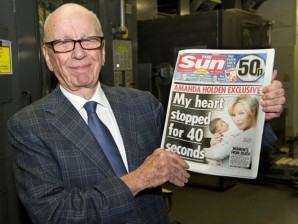Murdoch’s new Sun rises with decency vow
LONDON — Rupert Murdoch’s Sun on Sunday tabloid rolled off the presses for the first time, with a pledge that the paper replacing the scandal-hit News of the World would abide by standards of decency and trust.

NEW SUN RISES. A handout photo provided on Feb. 25, 2012 by News International Group Ltd shows the chairman and chief executive officer of News Corporation, Rupert Murdoch, holding the first edition of The Sun on Sunday as it came off the presses at Broxbourne, outside London. AFP
The 80-year-old media baron personally supervised the production late Saturday at a printworks in Hertfordshire, north of London, showing his support for what he hopes will be Britain’s most-read weekly newspaper.
The front page featured an interview with Amanda Holden, a British television personality who came near death after the birth of her daughter, with the headline: “My heart stopped for 40 seconds.”
Inside, an editorial titled “A new Sun rises today” said the paper was appointing a so-called Readers’ Champion to deal with complaints and errors, while also vowing that its journalists would be ethical.
“You will be able to trust our journalists to abide by the values of decency as they gather news,” it said.
But the editorial insisted that 10 Sun journalists arrested since November on charges of bribing police and public officials for information were innocent until proven guilty.
Murdoch, the Australian-born founder and head of the US-based News Corporation media empire, flew into Britain on February 16 to take charge of a crisis at The Sun after the most recent arrests.
He announced the surprise launch the following day during a visit to the Sun’s offices in London, just seven months after the News of the World was closed by a scandal over the hacking of mobile phone voicemails.
On Friday, Murdoch said on Twitter that there had been widespread speculation over the sales of the Sun on Sunday, but he would be “very happy at anything substantially over two million!”
The benchmark would put it comfortably in front of the 1.9 million circulation of The Mail on Sunday, currently the best-selling weekly paper in Britain.
The new paper is being sold at a knockdown price of 50 pence ($0.80, 0.60 euro cents) in a move that has already sparked a price war with some of Murdoch’s rivals.
The first editions that rolled hot off the presses — with British media reporting three million copies were being printed — stuck largely to the daily paper’s format.
It kept the usual large red masthead saying “The Sun” and just adding a small yellow sun and the word “Sunday” beneath it to show that is the weekly edition.
It also features new columnists such as Michelin-starred chef Heston Blumenthal, Archbishop of York John Sentamu, the second-highest ranking cleric in the Church of England, and former glamour model Katie Price, also known as Jordan.
The launch of the paper has been seen as an attempt by Murdoch to both wrongfoot critics and staff reportedly angry that News Corp. had given police the information that led to some of the arrests.
It has also been seen as a way of reassuring News Corp. shareholders in the United States that the firm is trying to move on from the News of the World scandal.
But sales of 2.75 million are needed to match the daily edition of The Sun’s average circulation and the sort of sales figures achieved by the News of the World.
The Sun on Sunday’s “red-top” rival the Daily Star Sunday cut its price to 30p while it is also likely to spark a price war with other papers including the Sunday Mirror and The People, which have all gained readers since the News of the World’s closure.
The News of the World’s June 2011 average sales were 2.67 million and while half of those readers have drifted off to other papers, 1.3 million have simply vanished from the market altogether, industry figures show.
Military chiefs have ordered thousands of copies of The Sun on Sunday to be flown to British troops serving in Afghanistan and the Falkland Islands in the South Atlantic Ocean, the paper said.
Australian-born Murdoch, who is now a US citizen, bought the Sun in 1969 and was pictured reading one of the first copies after he purchased it back then too.
He revolutionized Britain’s newspaper industry in the 1980s by taking his papers to digital printing in defiance of the trade unions then launched a price war in the 1990s that rival papers struggled to keep up with.